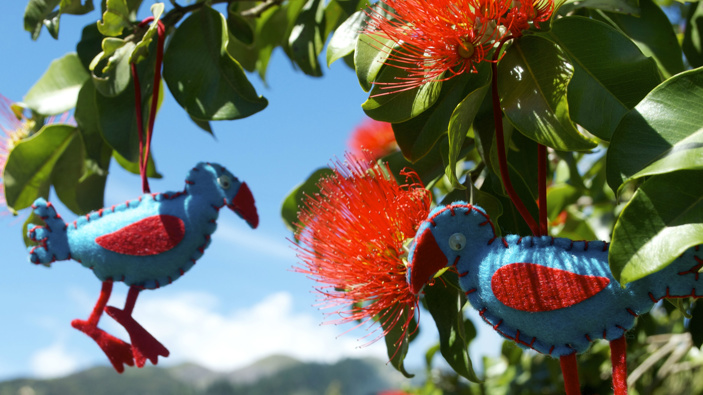Air traffic Control
Heading towards summer there are soooo many shrubs, climbers and trees in flower, luring in pollinators and other organisms, interested in the protein of pollen and the carbohydrates of nectar. On some plants it simply is great entertainment to just sit or stand still and watch what flies there. And it all flies there without air traffic control!
Pohutukawa and some of the rata species flower around Christmas and they’re usually very busy indeed.
The usual suspects: honey bees (Apis mellifera) and at least two species of bumble bees: the common, large earth bumblebee (Bombus terrestris) and the large Garden bumble bee (Bombus ruderatus). Their ideas are to gather nectar (it is merely sugar water, a quick energy fix with a kick) for energy and to store it as honey in the nest. They also collect pollen which is fed to the larvae (for growth)
The often unseen bees: Our native bee species (27 different species in all)! They tend to be small.
Most species are so-called “solitary” bees; a pair (but really... mostly the female!) digs their own, narrow tunnel in the ground; there she makes a small nest for a few off-spring, raised on nectar and especially pollen. On the food plants they stand out as active little dark-coloured bees. You’ll find them on Manuka as well.
The unexpected pollinators: flies of all shapes and sizes, colours and descriptions. The idea of a free lunch is simply too good for most of these insects. Houseflies, blowflies, fleshflies and Dilophus nigrostimus, a native Bibionid fly which is black and red and has a rather long-ish head. You often find these flies feeding in large numbers on pollen of flowers along the road-sides. Bibionids are known overseas as “march flies”; we often call them Blossom Flies, which seems a lot more appropriate.
Thrips: If you go to your optometrist regularly and look real close, you can even find thrips and such minute insects clambering around the pollen – it’s just part of the free-for-all. Many people think thrips are pests (and indeed, some of them are, but the majority are either predators of useful pollinators.
Beetles and other invertebrates: When rata and pohutukawa leaves emerge from the buds in spring, a lot of them have small, often circular, holes in them. Blame a tiny native weevil (Neomycta rubida) for these activities. The weevil is already present inside the unfolding buds to take advantage of the freshest virgin foliage on earth. The weevils lay their eggs in the leaf stalks and the ensuing larvae mine the foliage. Of course, when the small adult weevils cruise the Metrosideros leaves, birds are quite eager to snap them up. To a silvereye, they are nothing more than convenient, bite-sized packages of protein.
Some beetle species are also frequenting pohutukawa and rata flowers; that includes some ladybird beetles. Pollen and nectar provide them with the nutrients to lay eggs in amongst aphids and scale insects in your garden
In the rough bark live weta, large predatory flightless beetles and native roaches. You’ll see those at night. And although they might not fly around our Christmas Trees and rata vines, they are just as much part of the Aotearoa ecosystem of early summer.
LISTEN TO AUDIO ABOVE
Take your Radio, Podcasts and Music with you










